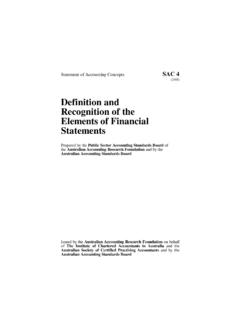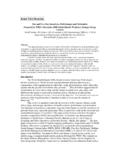Transcription of This PDF is a selection from an out-of-print volume …
1 This PDF is a selection from an out-of-print volume from the National Bureau of economic Research volume Title: financial Markets and financial Crises volume Author/Editor: R. Glenn Hubbard, editor volume Publisher: University of Chicago Press volume ISBN: 0-226-35588-8. volume URL: Conference Date: March 22-24,1990. Publication Date: January 1991. Chapter Title: The Gold Standard, Deflation, and financial Crisis in the Great Depression: An International Comparison Chapter Author: Ben Bemanke, Harold James Chapter URL: Chapter pages in book: (p. 33 - 68).
2 The Gold Standard, Deflation, and financial Crisis in the Great Depression: An International Comparison Ben Bernanke and Harold James Introduction Recent research on the causes of the Great Depression has laid much of the blame for that catastrophe on the doorstep of the international gold standard. In his new book, Temin (1989) argues that structural flaws of the interwar gold standard, in conjunction with policy responses dictated by the gold standard's "rules of the game," made an international monetary contraction and deflation almost inevitable.
3 Eichengreen and Sachs (1985) have presented evidence that countries which abandoned the gold standard and the associated contraction- ary monetary policies recovered from the Depression more quickly than coun- tries that remained on gold. Research by Hamilton (1987, 1988) supports the propositions that contractionary monetary policies in France and the United States initiated the Great Slide, and that the defense of gold standard parities added to the deflationary The gold standard-based explanation of the Depression (which we will elaborate in section ) is in most respects compelling.
4 The length and depth of the deflation during the late 1920s and early 1930s strongly suggest a mon- etary origin, and the close correspondence (across both space and time) be- tween deflation and nations' adherence to the gold standard shows the power of that system to transmit contractionary monetary shocks. There is also a high correlation in the data between deflation (falling prices) and depression (falling output), as the previous authors have noted and as we will demonstrate again below. Ben Bemanke is professor of economics and public affairs at Princeton University and a re- search associate of the National Bureau of economic Research.
5 Harold James is assistant profes- sor of history at Princeton University. The authors thank David Fernandez, Mark Griffiths, and Holger Wolf for invaluable research assistance. Support was provided by the National Bureau of economic Research and the National Science Foundation. 33. 34 Ben Bernanke and Harold James If the argument as it has been made so far has a weak link, however, it is probably the explanation of how the deflation induced by the malfunctioning gold standard caused depression; that is, what was the source of this massive monetary non-neutrality?
6 2 The goal of our paper is to try to understand better the mechanisms by which deflation may have induced depression in the 1930s. We consider several channels suggested by earlier work, in particular effects operating through real wages and through interest rates. Our focus, however, is on a channel of transmission that has been largely ignored by the recent gold standard literature; namely, the disruptive effect of deflation on the financial system. Deflation (and the constraints on central bank policy imposed by the gold standard) was an important cause of banking panics, which occurred in a number of countries in the early 1930s.
7 As discussed for the case of the United States by Bernanke (1983), to the extent that bank panics interfere with nor- mal flows of credit, they may affect the performance of the real economy;. indeed, it is possible that economic performance may be affected even without major panics, if the banking system is sufficiently weakened. Because severe banking panics are the form of financial crisis most easily identified empiri- cally, we will focus on their effects in this paper. However, we do not want to lose sight of a second potential effect of falling prices on the financial sector, which is "debt deflation" (Fisher 1933; Bernanke 1983; Bernanke and Gertler 1990).
8 By increasing the real value of nominal debts and promoting insol- vency of borrowers, deflation creates an environment of financial distress in which the incentives of borrowers are distorted and in which it is difficult to extend new credit. Again, this provides a means by which falling prices can have real effects. To examine these links between deflation and depression, we take a com- parative approach (as did Eichengreen and Sachs). Using an annual data set covering twenty-four countries, we try to measure (for example) the differ- ences between countries on and off the gold standard, or between countries experiencing banking panics and those that did not.
9 A weakness of our ap- proach is that, lacking objective indicators of the seriousness of financial problems, we are forced to rely on dummy variables to indicate periods of crisis. Despite this problem, we generally do find an important role for finan- cial crises particularly banking panics in explaining the link between fall- ing prices and falling output. Countries in which, for institutional or historical reasons, deflation led to panics or other severe banking problems had signifi- cantly worse depressions than countries in which banking was more stable.
10 In addition, there may have been a feedback loop through which banking panics, particularly those in the United States, intensified the severity of the world- wide deflation. Because of data problems, we do not provide direct evidence of the debt-deflation mechanism; however, we do find that much of the appar- ent impact of deflation on output is unaccounted for by the mechanisms we 35 financial Crisis in the Great Depression explicitly consider, leaving open the possibility that debt deflation was impor- tant. The rest of the paper is organized as follows.
















